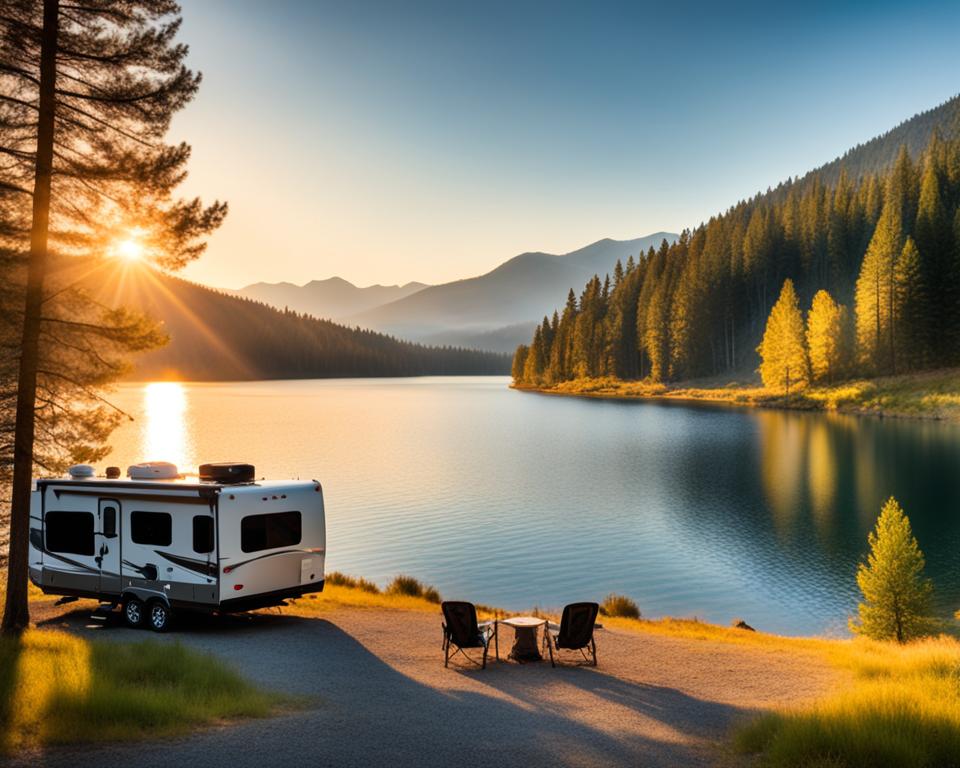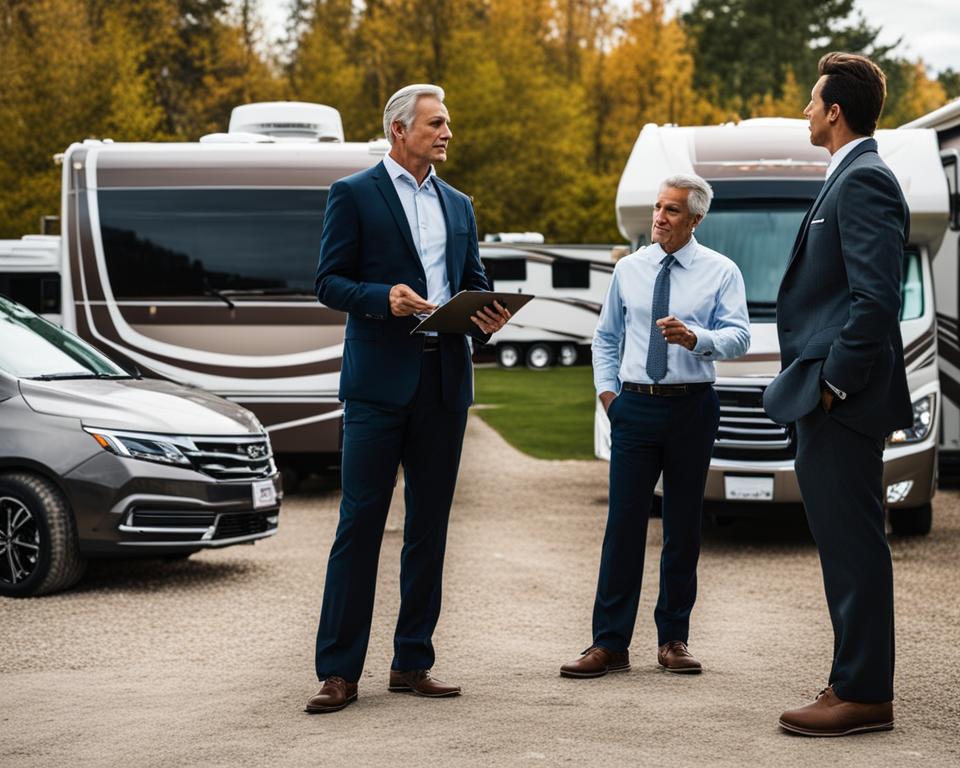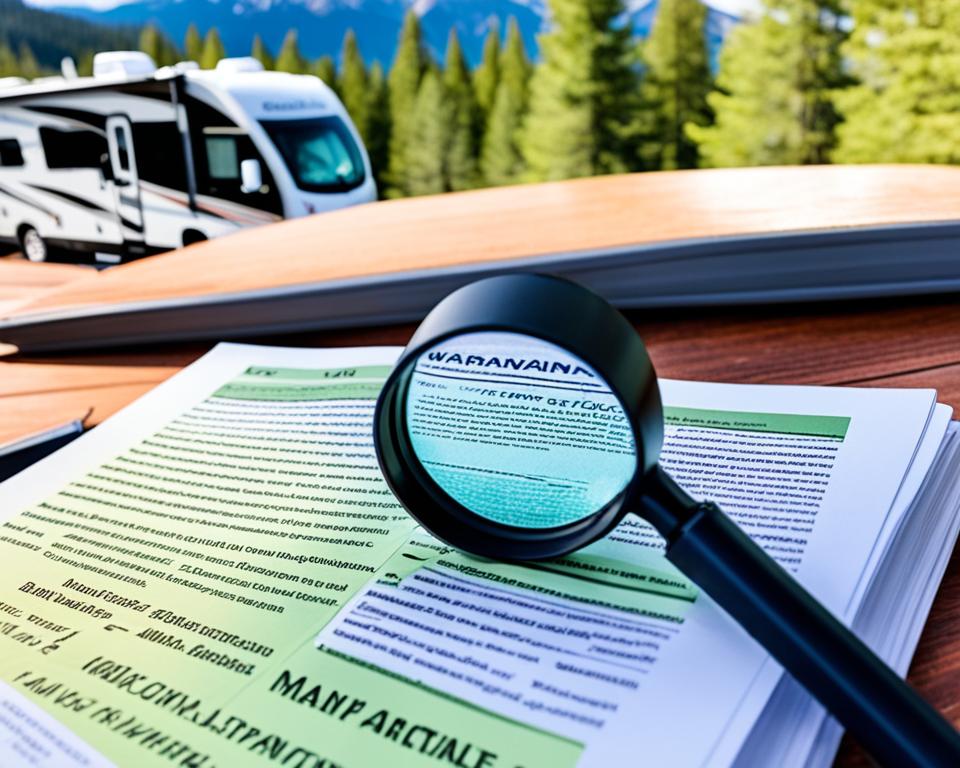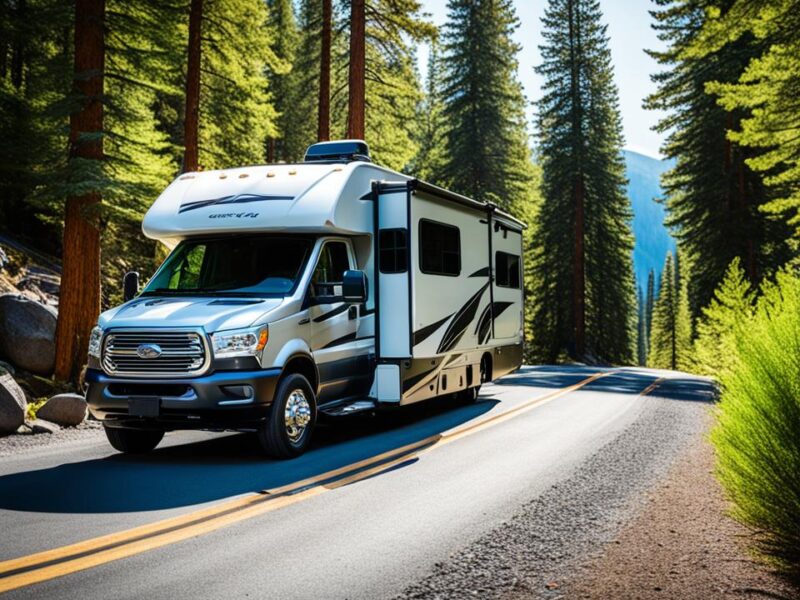Welcome to RecreationalVehicleGuide.com – your roadmap to freedom! Embark on your RV adventure with expert reviews, maintenance tips, and camping guides. Discover the best RV gear, explore the RV camping lifestyle, and stay updated on the latest RV topics. We are here to provide you with all the information you need to make the most of your RV experience.

Key Takeaways:
- Access expert RV reviews and maintenance tips to enhance your RV experience.
- Discover the best RV gear to make your camping trips comfortable and convenient.
- Explore the RV camping lifestyle and immerse yourself in nature.
- Stay updated on the latest RV topics to stay informed and connected with the community.
- Find all the information you need to make the most of your RV adventure at RecreationalVehicleGuide.com.
Common Misconceptions About Buying RVs
When it comes to buying an RV, there are several misconceptions that can lead to costly mistakes. From inflated prices and shady warranty deals to falling into the RV trade-in trap, it’s important to be aware of these common scams.
RV dealers often employ tactics to inflate prices and deceive buyers. They may advertise unrealistic discounts or promotions that create the impression of a great deal, but in reality, you may end up paying more than the fair market value. It’s crucial to do your research and evaluate prices from multiple sources to avoid overpaying for an RV.
Another misconception is related to shady warranty deals. Some dealerships may offer warranties that seem comprehensive but actually have hidden clauses that limit coverage or require you to use their authorized repair centers. Understanding the fine print and asking questions about what is and isn’t covered can help you make informed decisions and avoid unexpected costs down the road.
Furthermore, the RV trade-in process can be a potential trap if you’re not careful. Dealerships may offer you a seemingly attractive trade-in value for your old RV, but this value is often lower than the fair market value. Consider getting independent appraisals and exploring alternative options like selling independently to maximize your return on investment.
To safeguard yourself when buying an RV, it’s essential to take certain precautions. Research the dealership’s reputation and look for reviews from other customers. Get a thorough inspection of the RV by an independent mechanic or RV inspector to identify any hidden issues or damage. Lastly, don’t rush into a purchase, take your time to thoroughly evaluate the RV and negotiate the terms that work best for you.
In conclusion, understanding the common misconceptions surrounding RV buying can help you avoid scams and make informed decisions. By being aware of inflated RV prices, shady warranty deals, and the RV trade-in trap, you can safeguard yourself when buying an RV and ensure a smooth and enjoyable RV ownership experience.
Unveiling RV Sales Tactics
RV sales can be a thrilling experience, but it’s essential to navigate the process with caution. In this section, we will shed light on the various tactics used by RV dealers to make their prices and deals appear more attractive than they actually are. By understanding these tactics, you will be better equipped to make informed decisions and avoid any surprises along the way.
Misleading RV Pricing
One common sales tactic in the RV industry is misleading pricing. Dealers may advertise prices that seem too good to be true, only to reveal additional costs later. It’s important to carefully read the fine print and inquire about any hidden fees before committing to a purchase. By doing so, you can ensure that you are getting the full picture of the RV’s actual price.
Hidden Fees
In addition to misleading pricing, RV sales often involve hidden fees. These fees may include documentation fees, dealer preparation fees, delivery charges, or other miscellaneous expenses that are not initially disclosed. To protect yourself from unexpected costs, ask the dealer to provide a detailed breakdown of all fees upfront. This way, you can evaluate the true cost of the RV and negotiate if necessary.
| Common Hidden Fees | Estimated Cost |
|---|---|
| Documentation fees | $100 – $500 |
| Dealer preparation fees | $200 – $800 |
| Delivery charges | $500 – $2,000 |
| Other miscellaneous expenses | Varies |
Financing Options
RV dealers often present financing options to make their vehicles more affordable. While financing can be a convenient way to spread out the cost, it’s important to carefully consider the terms and interest rates. Take the time to research and compare financing options from multiple sources, including banks and credit unions, to ensure you’re getting the best deal.
Delivery and Dealer Preparation Fees
Delivery and dealer preparation fees are additional costs that might catch buyers off guard. These fees cover the expenses associated with inspecting and preparing the RV for purchase, as well as delivering it to your preferred location. It’s crucial to clarify these fees in advance and negotiate if necessary to ensure transparency and avoid any surprises.
“Understanding the sales tactics employed in the RV industry is crucial for making informed decisions and avoiding unnecessary costs. By being aware of misleading pricing, hidden fees, financing options, and delivery and dealer preparation fees, you can confidently navigate the RV sales process.”

Now that we’ve uncovered the various sales tactics employed by RV dealers, you are equipped with the knowledge to navigate the RV sales world with confidence. When armed with this information, you can make informed decisions, negotiate effectively, and ensure a smoother RV buying experience.
The Pressure of RV Dealerships
Stepping into an RV dealership can be overwhelming, with salespeople using pressure tactics to get you to make a quick decision. At RecreationalVehicleGuide.com, we want to ensure that you have a stress-free and informed RV buying experience. In this section, we will explore the pressure tactics commonly employed by RV dealerships and provide you with tips on how to navigate them.
Don’t Fall for Limited-Time Offers
One common pressure tactic used by RV dealerships is offering limited-time deals or discounts. While it may seem tempting to make a hasty decision to take advantage of these offers, it’s important to take a step back and assess if it truly aligns with your needs. Rushing into a purchase without careful consideration can lead to regret in the long run.
Beware of the Fear of Missing Out
RV dealerships often play on the fear of missing out (FOMO) to create a sense of urgency. They may tell you that the RV you’re interested in is in high demand or that there are other potential buyers waiting in line. Remember, it’s essential to prioritize your own needs and timeline rather than succumbing to the pressure of FOMO.
“The fear of missing out is one of the most powerful forces that motivates buying behavior.” – Robert Cialdini
Recognizing Emotional Manipulation
Emotional manipulation tactics can involve creating a sense of emotional attachment to the RV you’re considering. Dealerships might use storytelling, emphasizing the RV’s features that align with your desires, and even offering to include additional accessories or upgrades. It’s crucial to separate emotions from logical decision-making and evaluate the value proposition objectively.
Remember, the decision to purchase an RV is a significant one, and it’s essential to take your time, do thorough research, and feel confident in your choice. Don’t let the pressure tactics of RV dealerships sway you into making a decision that you may later regret.
Continue reading to learn how to decode RV warranties and navigate the trade-in process.
Decoding RV Warranties
RV warranties are essential for protecting your investment and providing peace of mind on the road. However, understanding the fine print and coverage limitations can be a daunting task. In this section, we will unravel the mysteries of RV warranties, ensuring you have the knowledge needed to make informed decisions.
The Importance of Reading the Fine Print
Knowledge is power when it comes to RV warranties. It is crucial to read the fine print carefully before signing any warranty agreement. This document contains specific terms, conditions, and exclusions that can affect what is covered and what is not. By taking the time to understand the fine print, you can avoid surprises and unexpected costs that may arise during the warranty period.
Understanding Wear and Tear Coverage
One aspect of RV warranties that often causes confusion is wear and tear coverage. While warranties typically cover manufacturing defects and mechanical failures, they may not extend to normal wear and tear that occurs over time. It is essential to clarify what falls under wear and tear coverage and whether it aligns with your expectations. This understanding will help you plan for potential repairs and budget accordingly.
Limitations of Authorized Repair Centers
Authorized repair centers play a vital role in the warranty process as they are often the designated locations for repairs covered by the warranty. However, it’s important to note that some warranties may limit your choice of repair centers. Verify whether the warranty requires you to use authorized repair centers exclusively or if you have the flexibility to choose reliable and trusted repair facilities outside their network.
“Understanding the intricacies of RV warranties can save you from unexpected expenses and frustration.”
By decoding RV warranties, minding the fine print, understanding wear and tear coverage, and knowing the limitations of authorized repair centers, you can make more informed decisions regarding warranty coverage and potential repairs. Take charge of your RV’s protection and set yourself up for a worry-free journey.
| Common Warranty Coverage | Exclusions |
|---|---|
| ● Chassis and engine | ● Wear and tear |
| ● Plumbing and electrical systems | ● Neglect or improper maintenance |
| ● Appliances and HVAC | ● Accidental damage or vandalism |
| ● Slide-out mechanisms | ● Modifications or alterations |
| ● Structural components | ● Acts of nature |

Image: An image depicting a happy RV owner with their warranty documentation.
Understanding the RV Trade-in Process
Trading in your old RV can be a convenient way to reduce the cost of a new one. However, it’s important to understand the trade-in process to ensure you’re getting the most value for your old RV. In this section, we will delve into the intricacies of RV trade-ins, including determining the fair market value, negotiating the trade-in value, and exploring alternative options like selling independently.
First and foremost, knowing the fair market value of your RV is crucial. This value represents the reasonable price that your RV would sell for in the current market. To determine the fair market value, consider factors such as the age, model, condition, and demand for your particular RV. Online resources like trusted marketplaces and RV valuation guides can provide valuable insights into determining the fair market value of your RV.
Once you have an idea of the fair market value, it’s time to negotiate the trade-in value with the dealership. It’s important to remember that RV dealerships may offer you less than the fair market value to maximize their profit. Be prepared to negotiate and advocate for the value you believe your RV holds.
When negotiating the trade-in value, consider any repairs or maintenance that may be required for your RV. Addressing these issues beforehand or factoring in the cost of repairs can help strengthen your bargaining position. Additionally, cleaning and sprucing up your RV before the trade-in process can make a positive impression on the dealership, potentially influencing the trade-in value.
“I recently traded in my old RV and learned the importance of researching the fair market value beforehand. Knowing what my RV was worth allowed me to negotiate a better trade-in value and avoid being shortchanged.” – Sarah, RV enthusiast
While trading in your RV may seem convenient, it’s worth considering alternative options like selling independently. Selling your RV independently can often fetch a higher price compared to the trade-in value offered by dealerships. Online platforms, RV classifieds, and local RV clubs can help you connect with potential buyers who may appreciate the unique features and history of your RV.
Selling independently does require more time and effort compared to trading in, as you’ll need to handle inquiries, showings, and negotiations. However, the potential for a higher sale price and greater control over the process can make independent selling a worthwhile endeavor.
Remember, whether you choose to trade in your RV or sell independently, being knowledgeable and prepared will ensure a more favorable outcome. Understanding the fair market value, negotiating trade-in value, and considering alternative options can help you make the most informed decisions when it comes to parting ways with your old RV.
| RV Trade-in Process | Pros | Cons |
|---|---|---|
| Convenience | Easier and faster process compared to selling independently. | May result in a lower value for your RV compared to selling independently. |
| Reduced upfront costs | The trade-in value can be deducted from the purchase price of a new RV, reducing initial expenses. | RV dealerships may offer less than the fair market value for your RV. |
| Simplicity | No need to handle inquiries, showings, or negotiations; the dealership handles these tasks for you. | Limited control over the trade-in value offered by the dealership. |
Conclusion
Congratulations on completing our comprehensive guide to buying an RV! Armed with the knowledge gained from this article, you are well-equipped to confidently navigate the RV buying process and make informed decisions that will enhance your RV adventure. By understanding common misconceptions, sales tactics, warranties, and trade-in processes, you can avoid scams and ensure a smooth purchasing experience.
As you embark on this exciting journey, we encourage you to keep in mind a few RV buying tips. First and foremost, always do your research and compare prices to avoid falling victim to inflated RV prices. Additionally, be wary of shady warranty deals and carefully read the fine print to fully understand what is and isn’t covered. Remember to assess the fair market value of your current RV before considering a trade-in and feel confident negotiating the trade-in value.
Making informed decisions throughout the RV buying process is crucial. Our goal at RecreationalVehicleGuide.com is to provide you with the resources and information necessary to make the most of your RV experience. Whether you’re a seasoned RV enthusiast or a beginner ready to embark on your first adventure, we’re here to support you every step of the way. Happy RV buying!
FAQ
What are some common misconceptions about buying RVs?
Some common misconceptions about buying RVs include inflated prices, shady warranty deals, falling into the RV trade-in trap, and being scammed. It’s important to be aware of these misconceptions to avoid costly mistakes.
What RV sales tactics should I be aware of?
You should be aware of misleading pricing, hidden fees, financing options, and delivery and dealer preparation fees. Understanding these tactics will help you make informed decisions when purchasing an RV.
How can I deal with the pressure tactics used by RV dealerships?
When faced with pressure tactics from RV dealerships, it’s important to take your time and make a decision that is right for you. Don’t be swayed by limited-time offers, fear of missing out, or emotional manipulation.
How can I understand RV warranties?
To understand RV warranties, read the fine print, understand what is and isn’t covered, and be aware of wear and tear coverage. Additionally, familiarize yourself with the limitations of authorized repair centers to avoid unexpected costs.
What should I know about the RV trade-in process?
When considering trading in your old RV, know the fair market value, negotiate the trade-in value, and consider alternative options like selling independently. By understanding the trade-in process, you can ensure you’re getting the most value for your old RV.


